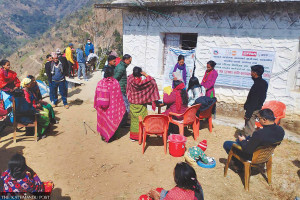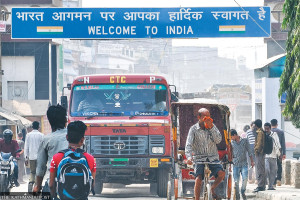 16.12°C Kathmandu
16.12°C KathmanduColumns
Mustang revisited
By the time of my third trip to this trans-Himalayan region in 1999, rapid change was evident.
Deepak Thapa
On a recent trip to Mustang, it suddenly struck me that Mustang was the only place to which I had returned repeatedly over the years. Four times is not a lot, but for one whose earlier peripatetic lifestyle has been shunted aside, it still counts for something. I also realised I had unwittingly been to our most famous trans-Himalayan region in all four seasons: autumn of 1985; winter, 1992-92; spring, 1999; and now summer of 2023. Today’s piece is a reflection on these trips.
The first was a full-on trek. A very bumpy Russian jeep ride from Pokhara to Phedi, below Naudanda, followed by a memorable walk via Ghodepani to Muktinath and then back via Beni, Baglung and over the Karkineta Pass to arrive at Nagdanda in Syangja. Those were the days before China had emerged as the factory of the world and the various accoutrements of a trek were quite unaffordable for the ordinary Nepali. The most we could afford were the essentials—rucksack, down jacket, sleeping bag and water bottle—all found in second-hand stores in Thamel. Even used trekking boots were out of the question and a walking stick was just that, a wooden staff that hotels on the trekking route would have stacked out in the courtyard, sometimes for a price but for Nepalis, usually free.
Those were also the days when Nepali trekkers were rare, and it was common for those running hospitality establishments along the route to overtly discriminate against folks like us. We were refused accommodation in at least two places and nearly kicked out from a third to make room for a Western couple who showed up late in the evening.
Reaching Kagbeni, the gateway to Lo, we were reminded how ignorant we were of our own country. For, early in the morning, we met a group of teachers heading up north to resume their duties after the Dashain break. These “Bahun masters”, as they used to be ubiquitously known all over northern Nepal, were coolly getting ready and regaling us with stories to our surely naïve questions about life up in what was till then a forbidden kingdom. Contrast that with the Kathmandu youngsters we were, with our copy of Stephen Bezruchka’s Trekking in Nepal to guide us and who had got a thrill from just walking beyond the police checkpoint the previous evening to get a glimpse of the indeed forbidding desert landscape and the lone route that snaked along the mountainside.
To Lo
December 1992. Hindu zealots had just torn down Babri Masjid and India was up in flames. The anti-minority zealotry had spread to Pakistan and Bangladesh. But once I landed in Jomsom, the deafening silence one would be greeted with blocked out everything else.
The walk up to Lomanthang was quite an experience. I barely came across anyone as I trudged up the trail—in communion with the landscape certainly but also very lonely. I did happen to bump into writer Manjushree Thapa on her way down. In fact, she was the only Rongba—the epithet used almost uniformly for southerners—I met beyond Kagbeni. Being mid-winter, only the elderly and children were to be found in the villages. As I was told, the able-bodied were in India—selling sweaters and other woollen garments bought in Ludhiana in Punjab to gullible north Indians who probably believed they were getting genuine Himalayan knitwear.
Having read Manjushree’s Mustang Bhot in Fragments, I met individuals who featured in it and for that reason felt a one-sided affinity with them. Likewise, I could still find echoes of Ekai Kawaguchi’s Three Years in Tibet (one of which was actually spent in Tsharang, the second biggest settlement of Lo) almost a century after his observations of the place.
The walled city of Lomanthang was what it was. There were no houses outside, but for a few hutments scattered here and there, particularly in the fields down below the plateau from which rose Lomanthang. The gates would be shut for the night. It was the emptiness and the quiet all around that was most striking.
By the time of my third trip in 1999, rapid change was evident. Despite the absence of a road connection with the rest of the world, motorcycles were already running around, taking advantage of the flat terrain of the Kali Gandaki Valley. Grand hotels had come up all along the trekking route. The road had reached Beni and there was great anticipation of the Mustang itself being connected soon along with the possibilities it represented such as for the apple farming industry that everyone seemed keen to get into.
A quarter century later, the upper reaches of the Kali Gandaki had been connected to the road for more than a decade. Travel was still perilous in some parts, but there were also tarred sections taking one seamlessly through some of the most breath-taking scenery anywhere in the world. Just like any village that gets a motorable road, the geography of most places had been altered. One felt sorry for the trekkers who, either for sentimental reasons or ignorance, braved the clouds of dust after each passing vehicle.
Besides the putative highway that leads all the way to the China border at Korala, roads had been and were still being cut into the mountainside in every direction one looked. Beyond Jomsom, there was even a road to nowhere—one that had been constructed but abandoned since an alternative route had been found.
Not one horticulturalist
The extension of apple farming was evident everywhere and it could not only be due to the effect of the summer foliage. Thousands and thousands of ropanis were teeming with apple orchards, some old but mostly quite new. Even in Upper Mustang, shrubland that had seemed inhospitable to any other vegetation had been taken over communally to grow apples. What was just as astounding was the lack of government support for an industry with such great potential. As I learnt, there is not a single horticulturalist or technician specialising on apples in the whole of Mustang! And, neither is there any support forthcoming for procedures like waxing apples to retain the moisture even though it is a technique that has been perfected for over a century. As a result, we get to enjoy Mustang apples for a few weeks of the year before they become soft and mealy, and the only succulent ones in the market are Chinese imports.
I had not imagined the extent of changes wrought on Lomanthang in the 30 years between my two visits. Its walls remained only ornamental since much of the activity was happening in the urban growth that has sprung up on the outside. The town itself is still pretty although the use of construction material could have been better regulated to retain the character it is so famous for. An example is given in the accompanying images: Taken from the same spot, the one on the left is the ward office, and directly across the street stands the yet-to-be-inaugurated new police station. Could the cops not even look around to see how out of place their new pad appears?



















